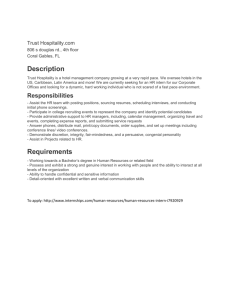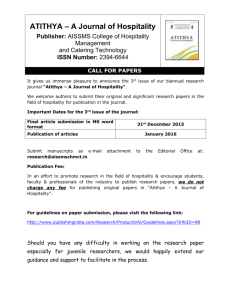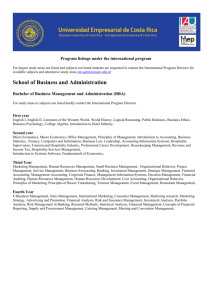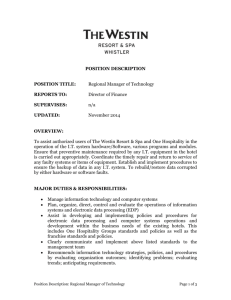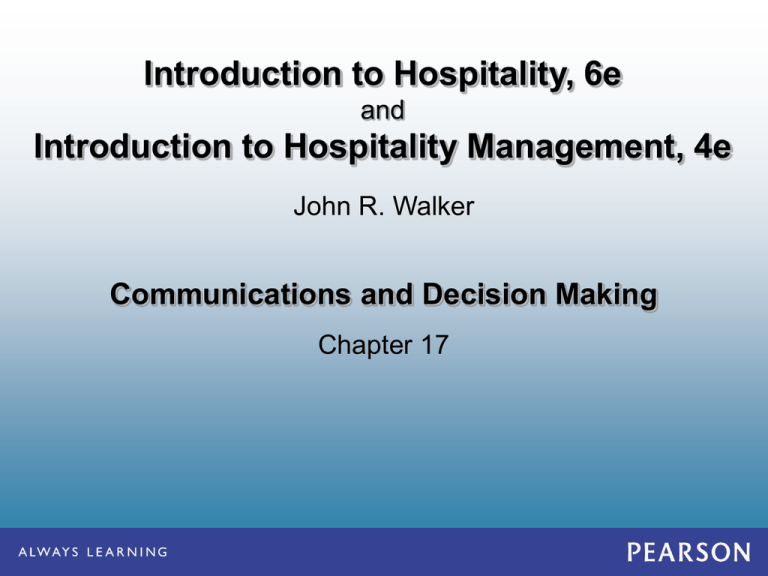
Introduction to Hospitality, 6e
and
Introduction to Hospitality Management, 4e
John R. Walker
Communications and Decision Making
Chapter 17
Managerial Communication
• Personal face-to-face.
• Telephone.
• Mail/fax.
• Memos, reports, log books, & other
internal/external written communication.
• Email, Internet web sites.
Introduction to Hospitality, 6e and Introduction to
Hospitality Management, 4e - Walker
© 2013 by Pearson Higher Education, Inc
Upper Saddle River, New Jersey 07458 • All Rights Reserved
Communication
• The definition of communication is the
exchange of information & meaning.
• The essence of communication is the
exchange of information.
• Another important aspect of communication is
understanding the meaning.
Introduction to Hospitality, 6e and Introduction to
Hospitality Management, 4e - Walker
© 2013 by Pearson Higher Education, Inc
Upper Saddle River, New Jersey 07458 • All Rights Reserved
Types of Communication
• Interpersonal:
– Between two or more people.
• Organizational:
– All the different forms, networks, & systems of
communication that occur among individuals,
groups, or departments within an organization.
Introduction to Hospitality, 6e and Introduction to
Hospitality Management, 4e - Walker
© 2013 by Pearson Higher Education, Inc
Upper Saddle River, New Jersey 07458 • All Rights Reserved
7 Elements:
Interpersonal
Communication Process
1.
The communication source
2.
The message
3.
Encoding
4.
The channel
5.
Decoding
6.
Receiver
7.
Feedback
Introduction to Hospitality, 6e and Introduction to
Hospitality Management, 4e - Walker
© 2013 by Pearson Higher Education, Inc
Upper Saddle River, New Jersey 07458 • All Rights Reserved
Noise
• Part of the interpersonal communication
process.
• Noise can consist of various activities going
on in the background, sounds of machinery or
coworkers, or as simple as static in the
telephone line or illegible print.
• Noise is considered a constant disturbance in
the communications process & the cause of
distortions of the message.
Introduction to Hospitality, 6e and Introduction to
Hospitality Management, 4e - Walker
© 2013 by Pearson Higher Education, Inc
Upper Saddle River, New Jersey 07458 • All Rights Reserved
Communicating Interpersonally
• When people are engaged in a conversation,
only a small fraction of the total message they
share is contained in the words they use.
• A large part of the message is contained in
gestures, postures, facial expressions, vocal
elements, etc. (this may = 2/3 of the
conversation).
– Nonverbal
– Body language
– Verbal intonation
Book Title
Author name
© 2012 by Pearson Higher Education, Inc
Upper Saddle River, New Jersey 07458 • All Rights Reserved
Barriers to Effective
Interpersonal Communication
• Perception
• Semantics
• Nonverbal communication:
– Misinterpretations
– Multicultural issues
• Ambiguity
• Defensiveness
Book Title
Author name
© 2012 by Pearson Higher Education, Inc
Upper Saddle River, New Jersey 07458 • All Rights Reserved
Overcoming Barriers
• Use feedback:
– Restate message for clarity.
• Active listening:
– Listening for the total meaning.
• Avoid triggering defensiveness.
• Interpersonal Dynamics:
– See next slide.
Introduction to Hospitality, 6e and Introduction to
Hospitality Management, 4e - Walker
© 2013 by Pearson Higher Education, Inc
Upper Saddle River, New Jersey 07458 • All Rights Reserved
Overcoming Barriers
• Interpersonal Dynamics:
– Have a great attitude toward your associates.
– Treat them fairly, with respect, & establish a climate of
trust.
– Include them in decision making.
– Be sensitive to cultural differences.
– Learn the best ways to communicate with your
associates.
– Make sure that your associates know what is expected.
– Actively listen to associates.
– Involve your associates.
– Train & develop associates so they can reach their full
potential!
Introduction to Hospitality, 6e and Introduction to
Hospitality Management, 4e - Walker
© 2013 by Pearson Higher Education, Inc
Upper Saddle River, New Jersey 07458 • All Rights Reserved
Formal vs. Informal
Communication
• Formal:
– Used by managers to communicate job
requirements.
– Follows chain of command.
• Informal:
– Discussion may be job related but may not be
essential to performing job duties.
– Does not follow chain of command.
Introduction to Hospitality, 6e and Introduction to
Hospitality Management, 4e - Walker
© 2013 by Pearson Higher Education, Inc
Upper Saddle River, New Jersey 07458 • All Rights Reserved
Flow of Communication
• Upward: takes place when superiors rely on
their subordinates for receiving information.
– It flows upward from employees to managers.
• Downward: flows down from supervisor to
employee.
• Lateral: takes place between the employees
of a company who are on the same
hierarchical level in the organization.
• Diagonal: takes place between employees
who are on different hierarchical levels & in
different departments of the organization.
Book Title
Author name
© 2012 by Pearson Higher Education, Inc
Upper Saddle River, New Jersey 07458 • All Rights Reserved
Communication Networks
• Chain: flows according to the existing chain of
command of an organization.
– This includes downward as well as upward communication flow.
• Wheel: communication flows between a strong
leader & each individual in a group or team.
– In this network coworkers communicate solely with their leader.
• All-channel: freely flowing communication
between all members of a group or team.
• The grapevine: one survey reported that 75% of
employees hear about matters first through
rumors on the grapevine!
Book Title
Author name
© 2012 by Pearson Higher Education, Inc
Upper Saddle River, New Jersey 07458 • All Rights Reserved
Decision-Making Process
1. Identify & define problem.
2. Identify decision criteria.
3. Allocation of weights to criteria.
4. Development of alternatives.
5. Analysis of alternatives.
6. Selection of alternative.
7. Installation of alternative.
8. Evaluation of decision effectiveness.
Introduction to Hospitality, 6e and Introduction to
Hospitality Management, 4e - Walker
© 2013 by Pearson Higher Education, Inc
Upper Saddle River, New Jersey 07458 • All Rights Reserved
Making Decisions
• Rationality: fully objective & logical.
• Bounded rationality: managers make decisions based
on the decision-making process that is bounded, or
limited, by an individual’s ability to gain information &
make decisions.
• Intuitive decision making is a subconscious process of
making decisions on the basis of experience &
accumulated judgment.
–
–
–
–
–
Values- & ethics-based
Experience-based
Affect initiated-based
Cognitive-based
Subconscious-based
Introduction to Hospitality, 6e and Introduction to
Hospitality Management, 4e - Walker
© 2013 by Pearson Higher Education, Inc
Upper Saddle River, New Jersey 07458 • All Rights Reserved
Types of Problems & Decisions
• Programmed: situations that recur on a
regular basis.
• Non-programmed: nonrecurring & made
necessary by unusual circumstances.
• Conditions under which decisions are made:
– Certainty
– Risk
– Uncertainty
Introduction to Hospitality, 6e and Introduction to
Hospitality Management, 4e - Walker
© 2013 by Pearson Higher Education, Inc
Upper Saddle River, New Jersey 07458 • All Rights Reserved
Decision-Making Styles
• Way of thinking: decision makers differ in their
way of thinking; some are rational & logical,
while others are intuitive & creative.
• Tolerance for ambiguity: managers with a
high tolerance for ambiguity save a lot of time
while making a decision.
– These individuals are able to process many thoughts
at the same time.
Introduction to Hospitality, 6e and Introduction to
Hospitality Management, 4e - Walker
© 2013 by Pearson Higher Education, Inc
Upper Saddle River, New Jersey 07458 • All Rights Reserved
Decision-Making Styles
• 4 major decision-making styles:
– Directive: low tolerance for ambiguity, rational thinker,
usually logical, & efficient.
– Analytical: large tolerance for ambiguity, require more
information before making their decisions, & consider
more alternatives.
– Conceptual: look at numerous alternatives, are
typically very broad in their outlook, & focus is on the
long run.
– Behavioral: work well with others, receptive to
suggestions, concerned about the achievements of
employees, commonly communicate through
meetings, & try to avoid conflict.
Introduction to Hospitality, 6e and Introduction to
Hospitality Management, 4e - Walker
© 2013 by Pearson Higher Education, Inc
Upper Saddle River, New Jersey 07458 • All Rights Reserved
Trends
• Trends such as improving technology to aid
with communication are likely to continue.
• An integral part of management’s decisionmaking process is the management support
system (MSS).
– The MSS has two distinctive elements: the
management information system (MIS) & the
decision support system (DSS).
Book Title
Author name
© 2012 by Pearson Higher Education, Inc
Upper Saddle River, New Jersey 07458 • All Rights Reserved
The End
Introduction to Hospitality, 6e and Introduction to
Hospitality Management, 4e - Walker
© 2013 by Pearson Higher Education, Inc
Upper Saddle River, New Jersey 07458 • All Rights Reserved


